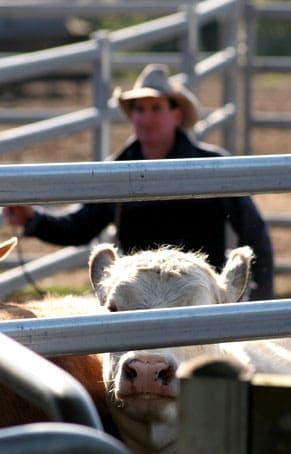DUBBO is not an area typically associated with live cattle exports, but recent demand trends in the central New South Wales region are reflecting the changing dynamics now at play across the broader Australian cattle market.
Northern live export buyers have been pulling cattle from as far south as Dubbo to fill livestock export orders for heavier cattle to ship to Vietnam from either Townsville or Darwin.
 At the same time, southern live export buyers have also been pushing as far north as Dubbo, which lies within Australia’s bluetongue-free zone, to buy breeding females for live export orders to China and Russia.
At the same time, southern live export buyers have also been pushing as far north as Dubbo, which lies within Australia’s bluetongue-free zone, to buy breeding females for live export orders to China and Russia.
It is a reflection of just how much the competitive landscape for cattle has changed in the past year.
Elders’ livestock sales manager for New South Wales, Paul Jamieson, told Beef Central that there was now a “multi-pronged attack” from different sectors for the same cattle.
“You have got live exporters, lotfeeders, processors and restockers all competing, and where they might have all competed in different weight or geographic segments of the market 12 months ago, many of them are now are competing for the same article,” he explained.
Market tug of war
Against this unusual backdrop, the question of where cattle prices move in coming months seems set to hinge on the outcome of a tug-o-war between tightening supplies of cattle and a potential easing in export demand.
It is unquestionable that a long-anticipated supply shortage following successive years of record cattle slaughter rates and beef export volumes is now looming.
Yardings at key livestock selling centres in Eastern Australia have been holding up relatively well so far this year, with the obvious exception of local rain impacts, such as at Roma on Tuesday. After more than 100mm of rain in some parts of the Maranoa, this week’s Roma store sale involved less than 1000 cattle, the second lowest store yarding at the centre since MLA has been keeping records.
Landmark’s Rod Turner expects numbers to return to 3000 to 4000 in the next few weeks, because there are still many producers wanting to sell cattle. But he suspects the giant 11,000 to 12,000 head yardings of last year will not be seen again for some time.
Producers with grass – and unfortunately there are still many without, in particular in Queensland’s drought-ravaged Central West – will focus now on putting weight on cattle and trying to breed numbers back up, which will curb supply to market this year.
Longer term, a return to high-volume cattle supplies will take a long time to eventuate, Mr Turner believes.
“A lot of herds (in western Queensland) are down to 30pc, some places are even less than that, some are completely destocked, so it is a long way back,” he said.
At Dalby, Peter Daniel of Grant Daniel Long said the usual run of weaners will start coming through in the next few months, but in fewer numbers than previous years.
While many producers needed to sell cattle for cash flow purposes, the higher prices available now compared to recent years meant that they didn’t have to sell as many cattle, he said.
Back in Dubbo, today’s yarding of around 3300 head is what would be regarded as a normal number for the centre, but well back on the large yardings of 4000 to 8000 head that were a regular sight last year.
Mr Jamieson said most of the areas he has travelled through in NSW recently were experiencing a reasonable season, supporting the expectations of tighter supplies available for the market this year.
The basic equation of tightening supplies versus multiple competing sources of demand suggests continued pressure on store cattle prices going forward.
But at the same time, some of those sources of competition are also easing, which could limit potential gains.
Citing demand issues in key end markets, such as the recent 30pc decline in beef exports to the United States, processor competition is being wound back as shifts are reduced and/or abattoir re-openings are pushed back after end-of-year seasonal closures.
‘Precariously poised’
Meat & Livestock Australia describes the current market conditions as “precariously poised.”
“On the one hand, reinforced by the recent northern rainfall, there is the expectation of tight cattle availability, which should support prices,” it said in commentary yesterday.
“At the same time, the US beef market, largely contributing to the aforementioned record beef export values, has declined 30pc, potentially limiting any further price gains.
“Following a record fall and record rise, the extremely flat start to 2016 may seem uneventful. However, given the forces at play, it will only be a matter of time before the cattle market starts following the path with the greatest power, as sideways movements rarely last long in Australia’s cattle industry.”



HAVE YOUR SAY